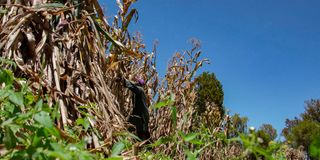Drought-defying early warning systems changing farmers' lives in Kilifi

Between 2020 and 2022, the Horn of Africa suffered its worst drought in at least 70 years
What you need to know:
- Research suggests pre-emptive intervention can save billions of dollars.
- A 2022 report by the World Bank found that spending $1 billion on early warnings can avert $35 billion of disaster-related losses annually.
For most farmers in Kilifi County, 2022 was a bad year. After months of toiling on their farms, the harvest was dismal. One farmer, though, had a different story. Amid the severe drought experienced in different parts of Kenya, Teresa Kahindi harvested nearly two tonnes of maize from one acre of land.
"They couldn't understand how I managed such a bumper harvest. Some asked questions, others applauded me but some accused me of witchcraft," she remarks. "But it is not true. We can't farm like we used to do. Now we must rely on climate forecasts." We are strolling through her fields of black-eyed peas, mug beans, cassava, finger millet and sunflowers.
Kahindi's drought-defying harvest, reaped in Kilifi's semi-arid Mariakani ward, was thanks to an early warning system, which span cutting-edge meteorological data produced by international, national and county collaboration, mass communication networks to alert millions of farmers through radio, television, SMS and WhatsApp messages, as well as on-the-ground teams to ensure that communities understand and take pre-emptive action.
Early that year, just a month before the March-May rain season, which typically brings the region's highest annual rainfall, Kahindi attended a seminar for farmers run by the county officials. It was here that she learnt about the predicted weather conditions specific to her county.
According to the county officials, farmers needed to adapt. To Kahindi, it was a cue to prepare her farm differently from previous farming seasons.
The first thing that she did was dig water retention pits, then cover the soil with dry grass mulching to reduce evaporation and plant drought-tolerant maize seeds, which require less water and mature faster than other varieties.
"Knowledge can transform farming," says Kahindi, who has since 2022 continued to closely follow early warnings, encouraging others in the community to follow her lead.
Kenya's early warning system, funded by the government in partnership with international agencies, may offer a template for countries to meet the United Nation's 2022 goal to protect "all people on Earth" by 2027 through early warning systems.
The UN launched the Early Warnings for All Action Plan for Africa in Nairobi last year to accelerate a slow rollout in other parts of the continent.
"In terms of early warning, Kenya stands out as a big brother for East Africa," says Zablon Shilenje, the World Meteorological Organization's coordinator for Africa. "The sophisticated system it has put together is one of the best in the region."
As extreme weather events increase exacerbated by human-induced climate change, the early warning system allows farmers to switch agricultural techniques or the crops they cultivate to adapt to predicted conditions, such as intense droughts or heavy floods.
Between 2020 and 2022, the Horn of Africa suffered its worst drought in at least 40 years, exacerbated by the climate phenomenon of La Niña. Some 23 million people required humanitarian aid at a cost of more than $1.8 billion.
More people will be exposed to drought as the region's population is set to double to 400 million by 2055.
Professor Tim Palmer, a food security expert at Oxford University says Kenya's early warning system has helped mitigate some impact of disasters – in turn minimising the likelihood of famine in one of the world's most food insecure regions.
Between 2010 and 2011, when repeated droughts struck the East African nation, 2.8 million Kenyans were left "severely hungry."
Thanks to early warnings, a million fewer people suffered during similar droughts in 2016 and 2017, even as the US government halved its spending on food aid, according to a report by the U.S. Agency for International Development, or USAID.
The effort to predict droughts dates back to 1985 with the founding of the Famine Early Warning Systems Network (FEWS NET), a USAID-funded programme that began in the aftermath of a catastrophic Ethiopia famine but now covers more than 50 countries.
Supported by Kenya's National Drought Management Authority (NDMA) and Agriculture Ministry, as well as international NGOs, the system uses high-resolution satellite, crop and other climate data to predict the risk of drought, sometimes up to eight months in advance.
Local authorities interpret, verify and communicate forecasts to millions of farmers through radio, television, SMS and WhatsApp messages and sometimes provide them with subsidised fertilisers and seeds.
"We can foresee severe events on time," says David Gikungu, director of the Kenya Meteorological Department. "This allows us to take prior action."
Advances in data collection, modelling and satellite monitoring have helped make early warnings more reliable over the years, offers Chris Funk, director of the Climate Hazards Centre at UC Santa Barbara, which processes most of FEWS NET's data.
Other improvements include an understanding of the complex climatic conditions that drive drought in the Horn of Africa and the region's communications infrastructure.
"We've come a long way," Funk says. "We have an impressive suite of tools now. It's been successful in stopping people from starving."
A study of FEWS NET data by US researchers found that 92 per cent of early warnings in Kenya were accurate, aided by better monitoring of socioeconomic factors, such as food prices and violent conflict.
While Kenya's early warning system is now highly accurate at predicting natural disasters, critics say decision-makers don't always act on time or with enough financial support.
"Unless the government and other stakeholders put up the resources, then it can't work," says James Odour, a former director at NDMA. "Unless action is taken on the early warning, then it's pointless."
Nelson Mutanda, responsible for early warning systems at the NDMA, says the government instructed counties to allocate 2 per cent of their annual budgets to early warning and gave local authorities the responsibility of managing funds.
"Counties have enough budget (to fund early warnings)," he said. "But some don't prioritise it. They can't come crying to us for support just because they haven't properly prepared." He adds: "And we expect farmers who are capable should take initiative without waiting for funding."
Research suggests pre-emptive intervention can save billions of dollars. A 2022 report by the World Bank found that spending $1 billion on early warnings can avert $35 billion of disaster-related losses annually. Another major challenge is disseminating warnings to rural populations.
In Kenya's southern county of Kajiado, home to the pastoralist Indigenous Maasai, drought warnings may not be understood, due to illiteracy rates, or sometimes are not even delivered when there are gaps in government or humanitarian resources.
"I need help, I would accept training," says Ole Mwato, a 46-year-old Maasai who lost 20 cows and 80 goats in the 2020-2022 droughts. "It's a lot of pain to lose the animals. There was no grass, no water. That's why they died."
Others resist undertaking laborious tasks, such as digging pits to retain water, seeing it as a potential waste of time because past forecasts were unreliable or traditional cultural beliefs that say the rains are controlled by the gods.
To improve forecast accuracy, FEWS NET is installing 50 low-cost, 3D-printed automatic weather stations across Kenya, including three in Kilifi. These stations can send highly accurate meteorological data every 15 minutes.
For now, Kahindi is leading by example, encouraging local farmers to adapt their methods to future weather to maximise yields. "We must work together to beat famine," she says.
This project was funded by the European Journalism Centre, through the Solutions Journalism Accelerator. This programme is supported by the Bill & Melinda Gates Foundation and co-published in partnership with Nation Media Group.



